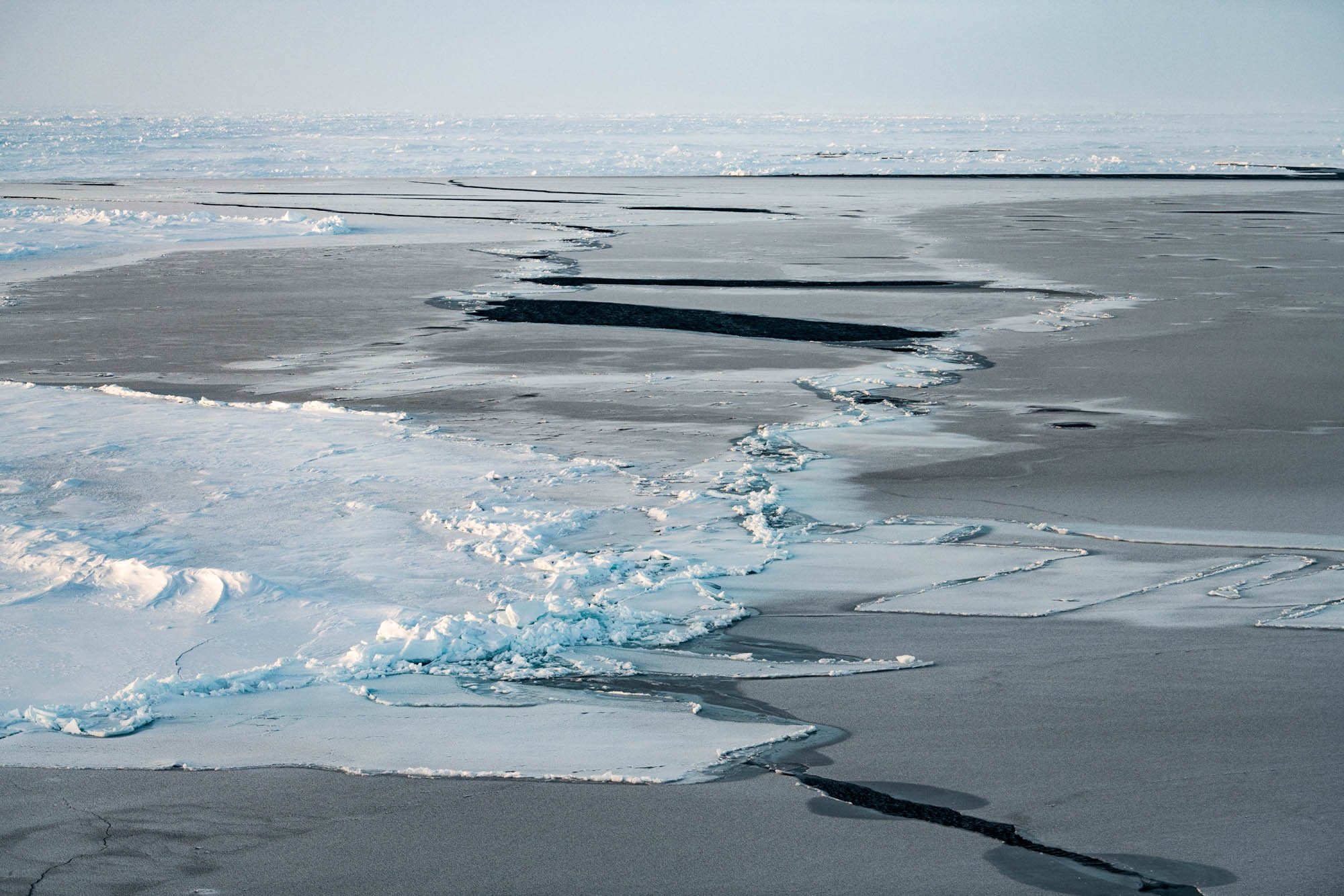Since September 20th, we’ve been in solid pack ice with few or no areas of open water. Our progress is slower, but steady most of the time. We move at between three and six knots (one knot = 1.15 mph) in the ice. As I’m writing, on September 22nd at 10:15 pm, we’re doing “backing and ramming,” which slows us down. When the ship is stopped by a pressure ridge or other thick ice, we back up enough to give us space to pick up speed to go forward and ram the ice to continue our journey north.
Pack ice with pressure ridges and open water.
We’ll be at 83° N soon, which is 420 miles from the Pole. It’s still light out. It will not get totally dark tonight, even though soon, the sun will drop below the horizon, as we move towards the Arctic night. It’s not particularly cold, hovering around 14° F all day. When there’s little wind, I can go outside and photograph without gloves for a few minutes, though I usually dress appropriately.
When we’re stopped at a station, I photograph less than when we’re moving, but there’s still so much to see. The light in the Arctic is different from that at lower latitudes. Colors are muted and soft; it’s incredibly beautiful. Today we were parked in a place with an area of flat, uncovered ice. Its textures and small variations create abstract structures.
Friday, September 23rd
Today was a full-day science station with limited visibility and no movement.
Composite image with broken-up pack ice.
Saturday, September 24th
It’s white-on-white today, with snow, fog, and snow-covered ice, making for very limited visibility. In the pack ice, control of the ship often passes from the bridge to Aloft CONN, which is a control room 93 feet above the water line. The additional height gives a longer line of sight to the horizon, if the horizon is visible at all. Because of the weather, we’ve foregone a science station today. We’re getting near 84°N, 360 miles from the Pole.
Since it’s looking like a non-photography day outside, I’m going to describe a bit of daily life on the ship. The Healy is a 420-foot-long icebreaker that was launched in 1997. The Coast Guard’s website explains that its “primary mission is to function as a world class high latitude research platform.” For the science work onboard, there are several labs: the main lab, the wet lab, the biological/chemical analysis lab, and the electronic/computer lab, as well as several staging areas inside and outside for deploying instruments and equipment. The science team, technical support team, crew, and the bridge all carefully coordinate the daily deployments. If you’re interested in learning more about the USCG Healy, there’s lots of information about it on the web.
Sunrise, clouds and pack ice.
I share a berth with two other men, and we share a toilet (head) and shower with the adjoining room. Our room includes a bunk bed or “rack,” and a single bed that is enclosed on the top. It’s nicknamed “the coffin.” I passed on choosing it for my bed. Each bed has curtains to block out light; it’s quite cozy in there. There is also a porthole, sink, gear lockers, file cabinets, and a couple of desks. Other than sleeping, none of us spend much time in our rooms. After three weeks aboard, we all get along well.
My rack (bed) and one of the many compartment doors we go through every day. There are five doors between the mess and the science labs
There are many “morale” events, and as I write in the Science Conference Room, one group is learning a board game, another is playing Dungeons and Dragons, and a third group, including the captain, is taking a lesson in playing the ukulele. Yesterday, I played ping pong and came close to beating Seth, one of the best players on the ship. I have high hopes of winning in the future. I also taught two people to play gin rummy. Unfortunately, both drubbed me.
Sunday, September 25th
Today we’ve been underway for three weeks. In the morning, we had snow and fog, but we were also in a lead (an area of open water in the pack ice) that enabled us to move along much faster than in the thick pack ice. Later, the skies cleared, and the blowing snow and wind gave the snowscapes an ethereal quality. If I don’t include the horizon when I frame an image, it becomes difficult to discern the scale of the scene. For example, low pressure ridges of ice that are only 10 or 15 feet above their base may resemble mountain ranges surrounded by snow-covered plains.
Overlapping floes in a frozen lead.
As the sun came out, the temperature quickly dropped, from about 17° F to 6°F, with 30 knot (about 35 mph) winds. I spent some time outside photographing; it wasn’t bad in the lee of the wind. At our location at 85°N, only 300 miles from the Pole, we had still had 11½ hours of sunlight.
“Mountains-in-Miniature.” These ridges are actually only 15-20 feet high.






